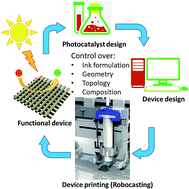Printing approaches to inorganic semiconductor photocatalyst fabrication
Abstract
Printing approaches to inorganic semiconductor photocatalyst fabrication potentially offer a simplified path to realising designer photocatalytic systems tailored to applications including water and air remediation, chemical synthesis, and renewable energy. Monoliths with controlled geometries, self-supporting foams, and microreactors, optimised for mass and photon transfer, unlock opportunities for improved photocatalytic efficiencies with better utilisation of low-abundance elements and energy resources. From a materials perspective, minimising material wastage through simplified single (or few) step fabrication processes is attractive for commercial exploitation. This review discusses conventional and emerging printing technologies and their application to photocatalytic materials and systems, highlighting key achievements and remaining knowledge gaps and challenges. Inkjet and extrusion printing are promising candidates for the fabrication of 3D patterned photocatalytic systems, although formulation aspects require further development. Printed photocatalytic foams are particularly interesting for the one-step fabrication of self-supporting photocatalysts. Further work is necessary to better understand and measure mass and photon transfer in complex 3D printed structures, wherein computational fluid dynamics (CFD) modelling may play an important role.

- This article is part of the themed collection: Recent Review Articles


 Please wait while we load your content...
Please wait while we load your content...